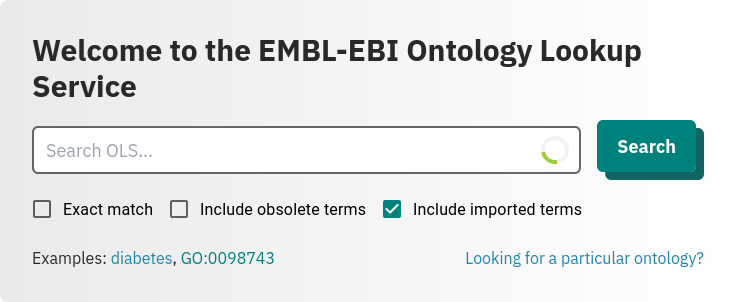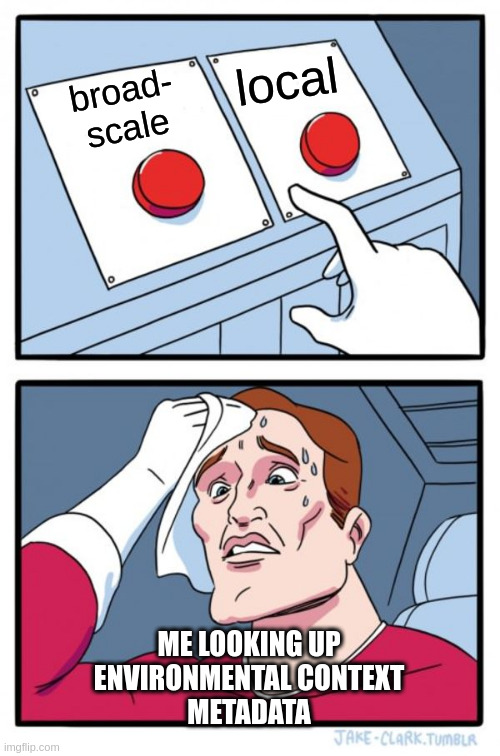Ontologies for biological data
2024-07-18
Learning objectives
- define an ontology and explain its features
- name at least two widely used ontologies in the life sciences
- navigate an ontology service and find specific ontology terms
Why bother with ontologies?
- increase findability of your dataset
- improve machine-readability of your datasets
- help others correctly categorize & re-use your datasets > recontextualization
- required by data repositories
- first step towards open linked data and knowledge graph representations?
Having fun with ontologies
Let’s talk about…
Having fun with ontologies


- Were you thinking of the baked goods, such as
cake [ENVO:02000063]? - unfortunately there was no well described ontology term for
pie - Or were you thinking of the
pie [44315]gene that encodes thepineapple eye protein (fruit fly) [PR:Q9VKW2]?
Ontology definition
List of terms, usually taken from the scientific literature
Ontology terms:
have curated textual definitions and synonyms
are arranged in a hierarchy from general to specific
have defined relationships with others terms (e.g.,
is_a,has_condition)have persistent identifiers
can be cross-referenced with other resources (ontology or not)
Ontology should reflect existing knowledge
Exercise: an ontology?
Task: Choose one of the definitions below and, if necessary add any missing features.
An ontology is:
A dictionary with persistent identifiers
A network of scientific definitions
A controlled vocabulary with synonyms
Search ontology terms
Search terms in ontologies
You can find terms in ontologies using the search bar of:


- others: The OBO Foundry, OntoBee mainly for developers
Ontology Lookup Service
OLS is the official ontology service of the EMBL-EBI
- EMBL: European Molecular Biology Laboratory
- EMBL-EBI: EMBL’s European Bioinformatics Institute
Demonstration: navigating OLS for term “intestines” in UBERON, ENVO
Ontology definition as demonstrated with the term “intestine”
Results, we found the term
intestine [UBERON:0000160]
in both ontologies UBERON and ENVO (as imported term from UBERON)
The correct writing convention for ontology terms and their term identifiers is: > term [ontology-acronym:sequence-number], e.g. intestine [UBERON:0000160]
Exercise: Ontology browser
Task: using Ontology Lookup Service v4
Look-up the following keywords in that order via the search bar: pond, ear and leaf
Select a term for each using these ontologies:
Uber-anatomy ontology (UBERON)
Plant Ontology (PO)
Environmental Ontology (ENVO)
Report the term and the term identifier in the pad

Exercise: visualize features
Navigate to 1-2 of the following terms:
Inspect the term page
Associate parts of the OLS interface with the expected features of an ontology
Let’s test your understanding of the features team vs. team
What questions do you have?
Learning objectives achieved?
- define an ontology and explain its features
- navigate an ontology service and find specific ontology terms
- name at least two widely used ontologies in the life sciences
Exercise: Find your ontology terms & connect the dots
Can we start the next lesson on selecting ontology terms for YOUR dataset descriptions?
TASK: Pick any 3 terms from your dataset description.
- Note them in the pad.
- Browse the OLS and find 1-2 suitable ontology terms for each.
- Add the ontology term identifiers to the pad.
- You have 5 minutes.
- Share your experiences.
- Who used an ontology besides UBERON, ENVO and PO? And why?
Exercise: Find your ontology terms & connect the dots 2
Connect the dots to repository metadata fields
- Select a suitable ENA checklist for your dataset and match your terms to one of the metadata fields.
- Write down the checklist identifier & metadata field.
- Are your terms fitting the metadata field requirements (field format, restriction)?
- Does the info box tell you to use specific ontologies?
- 10 more minutes
Environmental metadata according to established metadata standards
MIxS lists three mandatory environmental metadata fields that expect ontology terms.
| Metadata field | Abbreviation | Definition |
|---|---|---|
| broad-scale environmental context | env_broad_scale |
global correlation; ecosystem |
| local environmental context | env_local_scale |
in local vicinity; causal influences |
| environmental medium | env_medium |
immediate surroundings of your sample during sampling |
| Metadata field | Abbreviation | Recommended use of subclasses from |
|---|---|---|
| broad-scale environmental context | env_broad_scale |
biome [ENVO:00000428] |
| local environmental context | env_local_scale |
deeper hierarchy than broad-scale (UBERON terms accepted) |
| environmental medium | env_medium |
environmental material [ENVO:00010483] |
Exercise: Env* metadata

Task alone or by pairs:
Browse ENVO or UBERON (see previous table)
List ontology terms fitting your data
Fill out the following template on the pad:
env_broad_scaleenv_local_scaleenv_medium
trouble finding an appropriate term downstream of the recommended class? See instructions of using other ontologies with the MIxS standard
References
